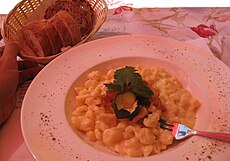
Liechtensteiner cuisine is the cuisine of Liechtenstein. The cuisine is diverse and has been influenced by the cuisine of nearby countries, particularly Switzerland and Austria,[1][2] and is also influenced by Central European cuisine.[3] Cheeses and soups are integral parts of Liechtensteiner cuisine.[1] Milk products are also commonplace in the country's cuisine, due to an expansive dairy industry.[2] Common vegetables include greens, potatoes and cabbage.[2] Widely consumed meats include beef, chicken and pork.[2] The consumption of three meals a day is commonplace, and meals are often formal.[2]
The cuisine of Liechtenstein, along with Uzbek cuisine, are the only two cuisines from doubly-landlocked countries.
Common foods and dishes[edit]

- Asparagus is frequently used
- Bread[2]
- Hafalaab – a soup with ham or bacon and cornmeal dumplings[4]
- Kasknopfl – small dumplings topped with cheese or onions[3][5]
- Liver[2]
- Muesli[2] – uncooked rolled oats, fruit and nuts that have been soaked in water or juice
- Pastries[2]
- Ribel – a grain[3]
- Rösti[1] – a dish prepared with coarsely grated potato that is fried. It may include regional variations that utilize additional ingredients
- Sandwiches[2]
- Saukerkas – a cheese produced in Liechtenstein
- Schnitzel – a breaded cutlet dish made with boneless meat thinned with a mallet.
- Smoked meats
- Torkarebl – a porridge dish that resembles dumplings
- Wurst – smoked sausages[1]
- Yogurt[2]
Common beverages[edit]
See also[edit]
References[edit]
- ^ a b c d Ver Berkmoes, Ryan (2007). Western Europe 8th Edition. Lonely Planet. p. 825. ISBN 978-1741042344. Retrieved January 31, 2013.
- ^ a b c d e f g h i j k l m n o p q Jacob, Jeanne; Ashkenazi, Michael (2007). The World Cookbook for Students, Volume 1. Greenwood Publishing Group. pp. 110–111. ISBN 978-0313334559. Retrieved January 31, 2013.
- ^ a b c "Cuisine of Liechtenstein." Archived 2011-09-28 at the Wayback Machine Gowealthy.com Archived 2010-08-07 at the Wayback Machine. Accessed July 30, 2011.
- ^ "Gastronomy in Liechtenstein". Studycountry. Retrieved 2018-11-09.
- ^ "Liechtenstein Cuisine." Europe-today.com. Accessed July 30, 2011.
Further reading[edit]
- Nelson, Kay Shaw (2004). Cuisines of the Alps. Hippocrene Books. ISBN 0781810582. Retrieved January 31, 2013. – Includes information about Liechtensteiner cuisine
External links[edit]
![]() Media related to Liechtenstein cuisine at Wikimedia Commons
Media related to Liechtenstein cuisine at Wikimedia Commons
Well, that’s interesting to know that Psilotum nudum are known as whisk ferns. Psilotum nudum is the commoner species of the two. While the P. flaccidum is a rare species and is found in the tropical islands. Both the species are usually epiphytic in habit and grow upon tree ferns. These species may also be terrestrial and grow in humus or in the crevices of the rocks.
View the detailed Guide of Psilotum nudum: Detailed Study Of Psilotum Nudum (Whisk Fern), Classification, Anatomy, Reproduction